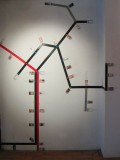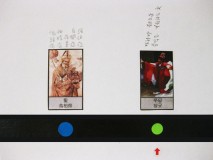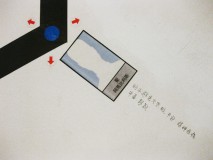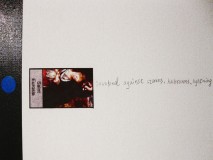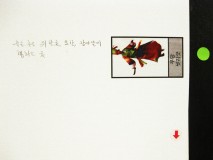Bo Pi Liao History Center, Taipei, Taiwan 2009
Religion is an organized approach to human kind’s quest for the sacred, and provides a structure for spirituality and connection to divine power. It is a universal quality of human nature to search for something beyond the ordinary, and to seek solace from life’s travails.
Map of Deities is an installation charting elements of the intricate religious belief systems of the East and the West, focusing on Taoism, Christianity, and Korean Shamanism and their symbols, beliefs, narratives, and practices. The structure is remaped onto evocations of mass rapid transit (MRT) system maps, and their Information Directory displays.
Located in the Wanhua district of Teipei City, Longshan Temple is the most celebrated Taoistic temple in Taiwan. In Taoism, there are many deities that people worship as they seek help in life. The word 道, Tao means ‘path’ or ‘way.’ Taoist propriety and ethics emphasize the Three Jewels of the Tao: compassion, moderation, and humility. Taoist thought generally focuses on nature, human-cosmos correspondence , health, longevity, wu wei (action through inaction), liberty, and spontaneity.
Taoist Deities in the Information Directory include:
The Three Pure Ones (Yuquing, Shangqing, Taiqing) – the gods of divine natures of all beings
Kuanyin – the goddess of mercy
Huangti – the god of martial arts for both good health and self-defense
Chang’e – the goddess of the moon
Mazu – the goddess of the Sea and of health, career, farming, relationships
Yu Huang – the god of heaven and hell
Guan Yu – the god of loyalty and righteousness
The Eight Immortals – the god of giving life or destroying evil
Yaochi Jinmu – the goddess of prosperity, longevity, and eternal bliss
In Christianity, there are patron saints who are regarded as the intercessors and advocates in heaven on behalf of nations, places, crafts, activities, classes, or persons. Patron saints, because they have already transcended to the metaphysical, are understood to be able to intercede effectively . Individual saints may be in charge of dealing with specific problems, diseases, or tasks.
Christian Patron Saints in the Information Directory include:
Saint Agricola of Avignon – protector against bubonic plague and misfortune of all kinds. Devotees prayed to him for good weather, fine harvests, and rain.
Saint Agrippina of Mineo – invoked against evil spirits, leprosy, thunderstorms, bacterial diseases, and bacterial infections
Saint Andrew Corsini – invoked against riot, civil disorder
Saint Bessus – protector of soldiers against the dangers of war; also invoked for fertility
Saint Christina the Astonishing – invoked against insanity, mental disorders
Saint Deodatus of Nevers – invoked for rain, and against thunderstorms, evil spirits, and plague
Saint Florian – invoked against fire, floods and drowning
Saint Holos – invoked for general well being, health, and healing
Saint Wulfram of Sens – protector against the dangers of the sea
Korea shamanism is practiced mostly by female shamans or Mudangs (무당, 巫堂) who hold various “gut” or rituals. The spirit-world of Korean Shamanism is complex and diverse, with spirits and gods of differing kinds and characters. For the most part, they are considered personal in nature: talking with individual humans, helping the weak, punishing the bad, and also directing people along the right path. The spirit-world of Korean Shamanism includes spirits of nature and spirits of ancestors, as well as spirits guiding regions and spirits guiding individuals.
Korean Shaman Rites in the Information Directory include:
Manmuk gut – Performed three days after a death in order to open a passage way to the land of the dead.
Dari gut – This rite is dedicated to the spirit of a deceased person and facilitates the entry into the land of the dead. Its procedures resemble some Buddhist rituals.
Naerim gut – This initiation rite is a traditional nerium-gut.
Jinogwi gut – This gut is performed for the dead. It helps guide the dead to paradise by and salvation by protecting them from angry spirits along their journey.
Baeyeonsin gut – This rite is a fishermen’s rite honoring of the dragon king of the sea. Its purpose is to wish for an abundant catch and to request communal peace all year round.
By focusing on Taoist deities, Christian saints, and Korean shamans (Mudangs), Map of Deities illustrates people’s attempt to understand the world and the self, as well as to express everyday wishes and desires through the individual belief systems they have mapped out for themselves.







